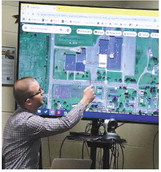Strong private-land harvest is a goal in Taylor County; CWD tests key in 2019
The white-tailed deer population appears to be strong and more hunters have antlerless authorizations than they’ve had since early this decade, which should lead to another bump upward in the harvest numbers in Taylor County for the 2019 nine-day gun deer hunting season.
Starting next weekend we shall see if nature cooperates.
This year’s hunt begins next Saturday, Nov. 23, the latest possible date in Wisconsin’s season framework. There are plusses and minuses to that.
While some hunters may be disappointed that the rut may be reduced or completed in many areas by then, others may see deer getting back to normal feeding and travel patterns.
While some may think the late start means better chances of winter-type weather, others may be encouraged by the increased chances of snow being on the landscape, improving visibility in the woods.
“I don’t know how much rut activity we’re going to see, but deer should be slipping back into normal patterns,” said Josh Spiegel, the Wisconsin DNR wildlife biologist for Taylor and Rusk counties. “There’s probably going to be a small gap in there where the rut will be calming down going into gun season. Therefore those bucks should get some time to rest and get back into a more regular movement pattern versus that strong rutting activity. Consequently, in the back end of our gun deer season we may even see some of that fabled ‘second rut’ where some of the does might kick back into a second cycle if they weren’t bred and potentially see some late-season activity on the back end of that too.”
Snow cover is starting to feel like a given considering below-average temperatures and above-average precipitation that have been present most of the fall in northern Wisconsin.
“That late in the season, we’re a little bit closer to the winter months, and there’s a good chance we might have snow on the ground,” Spiegel said in an Oct. 29 interview.
In Taylor County, deer numbers have slowly but surely been rebuilt since the back-to-back harsh winters of 2012-13 and 2013-14. They have gotten to the point where the Taylor County Deer Advisory Council, in its spring quota-setting meetings, debated if it is time for hunters to more aggressively pursue antlerless deer on the county’s private lands.
In April, the council approved bumping up antlerless authorization numbers from 5,000 to 5,600 on private lands for the 2019 hunting seasons and the quota on those lands from 1,700 to 1,900.
Spiegel said all indications are that deer are doing well here. Nine-day gun deer harvest numbers in Taylor County last year increased from 3,220 in 2017 to 3,517 in 2018 with a near 6% increase in the buck registrations (1,978) and a 14% increase in antlerless registrations (1,539), a figure helped by more permit availability.
“Last winter it was tough at times,” Spiegel said. “It probably weeded out a handful of deer, but for the most part the deer came out pretty healthy looking. That should result in more deer out there now.
“Fawn production looked pretty good, does looked healthy and the young deer looked pretty healthy,” he added. “I haven’t seen a ton of bucks to actually get a good idea of antler development yet. We’ll be looking at a lot of that come gun season. But all indications are with the wet summer there was a pretty good growing season and a lot of vegetation. So you would think the nutrition would be there, both from a young deer growth and survival standpoint and with the antler growth.”
The County Deer Advisory Council has remained cautious in issuing antlerless authorizations on Taylor County’s public lands. The quota remained the same as last year at 200. But with a surprisingly- low 28.7% success rate on the 499 tags that were purchased last fall, permit numbers went up to 675 and they, as expected, sold out quickly on the first day they were available.
Despite the low success rate, a posthunt survey of public-land hunters conducted by Spiegel showed most were pleased with what they saw on those lands. Only 16% of hunters said they were fairly or very dissatisfied with their public-land hunts in Taylor County in 2018. On the other hand, 59% were either fairly or very satisfied and another 25% were neutral.
“One thing that’s unique with Taylor County and a couple of counties east and west of us is we’re the first wave of the big woods up north,” Spiegel said. “A lot of people heading north hit Taylor County and venture out on the Chequamegon (National Forest) or other public land here. I think we see a lot of that. So there’s continued interest from those folks. The hunter survey and the satisfaction from the public land hunters was very high. So that was something really good to see and hear from our general public.”
Hunters who haven’t visited their preferred hunting spots yet should be aware that spots near streams and creeks may be wetter than normal. Spiegel said a second consecutive strong acorn crop may be something to keep in mind when trying to figure out deer feeding patterns.
From the DNR’s perspective, the 2019 gun deer hunt in Taylor County will be a big one because it is aiming to test at least 300 deer for chronic wasting disease. The entire 18-county Northern Forest Region is being targeted this winter for heavy CWD surveillance.
“We’re not trying to search for CWD as much as we’re hoping to verify it’s not here,” Spiegel said. “It’s kinda nerve wracking for hunters. We’re getting a lot of folks that do have some concern because it’s tied to a big political string with baiting and feeding and everything like that. We’re not trying to find CWD. We’re hoping to verify it’s not here. That’s our ultimate goal. And, at the end of the day we’re providing an extra service to the hunters where they get a free test on their deer. I think I can speak for most hunters. If I know my meat’s clean and good, I’m happy. You take that risk factor out.”
The DNR has been picking up deer for testing at four unmanned locations throughout the fall. They are the Medford DNR Ranger Station, the Rib Lake Cenex CStore station, The Gilman Corner Store and the Sheldon Northwoods Country Store. Buck Stop Taxidermy and Team Smackdown Outdoors Taxidermy just outside of Medford and the Conrath Quality Meats near the county’s northwest corner are also helping out with collecting samples from hunters.
Through the efforts of the Taylor County Sportsman’s Club Medford DNR Ranger Station also will have a dumpster available to collect deer carcasses during the nine-day and muzzleloader season for any hunter who wishes to dispose of a carcass.
For more information, see page 2 of this section.




